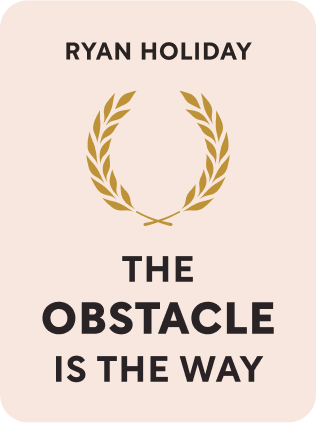

This article is an excerpt from the Shortform book guide to "The Obstacle Is The Way" by Ryan Holiday. Shortform has the world's best summaries and analyses of books you should be reading.
Like this article? Sign up for a free trial here .
Is stoicism relevant to modern life? What life lessons could you extract from Stoic philosophy?
Stoicism is a timeless philosophy. The ancient Stoicism teachings contain some of the greatest wisdom in the history of the world, and the Stoic lessons are no less relevant today than they were at the dawn of the stoic school of thought.
Here are seven Stoic lessons for modern living.
7 Stoic Lessons to Help You Thrive in a World You Can’t Control
Stoicism began in ancient times, but its lessons are as relevant today as they were at the times of Zino of Citium, the founder of the Stoic school of thought. Here are seven Stoic lessons to help you thrive in the world out of your control.
Lesson 1: Think Differently
People often advise you to be realistic and avoid rocking the boat. However, this limited thinking makes it harder to overcome obstacles. It also keeps you from trying to reach ambitious goals. Your perceptions often determine what you accomplish—if an obstacle looms bigger in your mind than the goal, it will stop you. Instead of listening to naysayers, and therefore accomplishing little or nothing, think differently.
Thinking Outside the Box: Steve Jobs
Steve Jobs operated with a mindset that people around him referred to as his “reality distortion field,” where he believed that nearly anything he wanted was possible.
He had little tolerance for lack of confidence or arguments that something couldn’t be done. For example, when he wanted to develop a new mouse that could move smoothly in any direction (a new concept at the time), he fired a designer who told him it couldn’t be done. The designer’s replacement immediately set about proving Jobs’s view of reality by creating the mouse.
In another instance, his engineers insisted they couldn’t have the first Macintosh computer ready for shipment by the deadline, which was one week away; they wanted an additional week. However, Jobs refused to accept a delay, the engineers performed beyond what they thought possible, and the Mac shipped on time.
By pushing past what others saw as insurmountable obstacles, Jobs created products no one had previously imagined.
Lesson 2: Find the Opportunity
Preconceptions about a situation or problem often set you up for failure. You assume things should be a certain way and when they’re not, you feel you’re starting from behind and give up. But in every situation or obstacle, there’s a hidden opportunity that you can turn to your own benefit.
When faced with an obstacle, do two things:
1) Manage your emotions, so you can see the situation neutrally.
2) Then mentally turn the obstacle upside down—reorient your thinking to view it as an opportunity or gift rather than a problem.
For example, when you have a horrible boss, all you see is daily misery. But think of it as presenting opportunities like these:
- You could quit (as you keep saying you should do), and open the door to new experiences.
- You could experiment with new tactics and solutions to see how they affect your boss’s behavior.
- You could see your situation as a learning opportunity—for instance, practice communication skills by standing up to the boss or add a new skill set—while updating your resume.
Consider being thankful for these irritants instead of being upset:
- Rude, disrespectful people give us an edge because they underestimate us.
- Those who denigrate our abilities allow us to easily exceed expectations.
- Lazy people make our accomplishments that much more impressive.
Turning Obstacles Upside Down: Gen. Dwight D. Eisenhower
General Dwight D. Eisenhower broke German momentum in World War II by using an obstacle to his advantage.
The German Blitzkrieg strategy of making sudden attacks with overwhelming force was initially disastrous for the Allies. But Eisenhower turned the Germans’ strategy upside down: He allowed them to break through Allied frontlines—then the Allies would surround the enemy force, attacking from all sides.
Lesson 3: Build on Failure
We’ve all heard stories of valuable lessons learned from failure. We know that failure is part of the path to success. Yet most of us will do anything we can to avoid failure—it’s embarrassing and painful.
But the temporary failure that comes as a consequence of taking action is less painful than permanent failure that comes from never trying and never learning. Learning from failure does come at a cost, whether in discomfort or lost time of having to start over. But be glad to pay it—there’s no better teacher than failure.
Think Like a Startup
Startups in Silicon Valley treat failure as an asset. Instead of spending months or years trying to develop the perfect product, they often launch an imperfect one so they can learn from the customer response.
Referred to as the MVP or minimum viable product, the first iteration is a core product with minimal features. Based on the customer response, the developers drop features that don’t work or aren’t wanted, and focus on improving the features customers do want. This approach allows them to fail without losing a lot of money rather than invest huge sums in something that doesn’t sell.
Think of yourself and your goal as a startup. Expect to fail and treat it as an asset. Each time you fail, learn from it and improve on your effort a little more. Develop a high tolerance for failure because successful action and failure go together. If you stop acting because you don’t want to fail, you won’t fail—but you won’t succeed either.
Lesson 3: Take Things One Step at a Time
The best way to tackle a difficult problem or obstacle is to break it down and focus on doing the first step. Do it well, then move on to the next step and the next. Don’t think about the end goal, just what you have to do now.
When you follow the process, problems and the action required to overcome them are less daunting—it’s just a matter of following the steps.
The step-by-step process counters several unhelpful responses to challenges or pressure:
- We have a tendency to become distracted or caught up in worrying about the future. Following the steps keeps our perceptions under control, so we don’t exaggerate problems in our minds and become paralyzed. It also keeps us moving forward.
- When under pressure, we tend to react instinctively and sometimes counterproductively. For instance, if someone knocked you down and pinned you, your reaction would be to panic and try to lift the person off of you, which wouldn’t work and would only exhaust you. The way to free yourself is taking a series of small, deliberate steps, starting with bracing your arms in front of you to gain breathing room, then turning on your side, grabbing an arm or leg, and so on.
A key benefit of breaking things down into steps and following them is that it’s relaxing. You know you’ll get the job done and can be comfortable taking whatever time it takes. The process replaces fear and worry.
A Winning Formula for Basketball
Nick Saban, coach of the University of Alabama football team, teaches his staff and players to focus on the present and take things one step at a time. Everyone involved refers to this as “the process.”
Players don’t focus on the next play, next game, or the SEC championship; they think only about completing the task in front of them, whether it’s a film session, drill, play, or drive. During games, they learn not to be distracted by the stakes, the score, or the crowd.
The goal is to excel at each step, which is the way to achieve overall success, whether winning a game or having a winning season.
Lesson 4: Do Your Job Well, Whatever It Is
When you’re pursuing an ambitious goal, you sometimes have to do “grunt work” or work that isn’t appealing to you along the way. It’s tempting to do this work haphazardly; you tell yourself the work doesn’t matter—it’s not who you are, you’re destined for bigger things.
However, whatever you’re doing, it’s your duty to do it well. The saying, “How you do anything, is how you do everything,” applies. The way you approach small things is the way you’ll approach big things.
Everything you do is an opportunity to learn and put your best foot forward. Whether you get recognition or are paid well is beside the point; what matters is that you do as much as you’re capable of.
Regardless of the job, always do three things: work hard, be honest, and help others. Remember that everything you do reflects on you.
Your answer to the question, “What’s the meaning of Life?” lies in your actions. In every step of every job, strive for right action; it’s a way to turn obstacles into opportunities. You always have this option.
Presidents Who Sweated the Details
Long before he entered politics and became president, Andrew Johnson was a tailor. Later, as president, he still expressed pride in the quality work he had done making clothes. He regularly noted that the clothing he made never ripped or came apart. When a campaign heckler ridiculed his working-class roots, Johnson replied that he was proud of having done good work that met his customers’ expectations.
Similarly, President James Garfield once had a humble job, which he did so well it became a jumping off point for a career. While attending college, he paid his tuition by working as a janitor. He did the work conscientiously and with a smile. Within a year, he became a professor, and by age 26, a dean.
Both presidents knew that doing even small things well is satisfying and empowering.
Lesson 5: Do What Works
People often describe pragmatism as being realistic, but it’s more a matter of being flexible—of going with what you have rather than waiting or striving for perfection.
At some point, you usually have to compromise to get things done. While he cared about details, Steve Jobs knew when to be pragmatic. The first iPhone didn’t have all the features he wanted, but there came a point when introducing a revolutionary device was more important than perfection.
Aim for momentum, not perfection. Act when you have all you need, but not necessarily all you want—and you’ll create enough force to break up obstacles.
Pragmatism Wins in Business and Life
Two fruit companies once battled for control of a tract of land of disputed ownership between Guatemala and Honduras. The company that took the pragmatic approach won.
United Fruit Company deployed a team of lawyers to file suits; the much smaller company owned by Samuel Zemurray simply met with each of the two purported owners and bought the land from each of them. Though Zemurray paid twice, his pragmatism overcame the obstacle—he got the land.
As a boy in the Jim Crow South, author Richard Wright confronted a roadblock, he came up with a practical means of getting what he wanted. He wanted to learn, but couldn’t check out library books because he was poor and black. So he forged notes requesting the books he wanted—he made the notes sound as though they were from a white person, who had sent him to pick up the books.
Lesson 6: Have a Larger Purpose
In challenging times, it’s easy to hunker down and focus on yourself, obsessing over what you did wrong and how to get out of your situation. But what you really need to do is adopt a cause larger than yourself.
Ask yourself how you can at least help others, if you can’t help yourself. If you just focus on yourself and why bad things keep happening to you, you’ll stay stuck. But when you realize your ability to do some good, you’ll feel empowered.
Everyone has problems and is subject to twists of fate. Others have had the same problem you’re having. Appreciate the fact that you’re part of a larger whole; contribute by helping others. In persevering for others’ sake, you’ll help yourself.
POW With a Mission: James Stockdale
U.S. Navy fighter pilot James Stockdale was shot down in North Vietnam in 1965, and captured by the North Vietnamese. He persevered through seven years as a prisoner of war by making it his mission to provide leadership and help the other POWs (including John McCain) get through the ordeal.
Stockdale gave the men a watchword—U.S., meaning “Unity over self”—to remind them that they were all in it together. He made it clear that no one would be blamed for giving up information under torture—everyone was human—and he set up a support network for those who felt ashamed.
Stockdale and McCain were able to withstand great torture. They weren’t superhuman—they drew strength from having a larger cause, their men’s well-being, which enabled them to persevere and help others persevere.
Lesson 7: Focus on the Present
When something happens or we face a challenge, instead of seeing it as it is, we obsess over what it means. This tendency is unique to the human species. As Emerson noted, we “waste time on false constructs”—spending our days conjuring up explanations for why things are the way they are. This makes obstacles seem bigger and more difficult to deal with. Instead of analyzing what problems mean, we should simply address them in the present.
Here are some tips for focusing on the present:
- Remember that the meaning or implications of obstacles are theoretical, and they may or may not be realized at some point in the future. We can only act in the moment.
- Try these methods to pull you into the present: Exercise, unplug from electronic devices, meditate, take a walk, or get a dog (they live in the present).
- Stop your mind from wandering and set aside distracting thoughts. This moment in your life (not what it means) is all that needs to occupy you now.
Succeeding in the Present
Half of Fortune 500 companies started in an economic crisis or bear market. They include:
- Standard Oil: 1865, the last year of the Civil War
- Coors: 1873 depression
- General Motors: Panic of 1907
- Revlon and United Airlines: Great Depression
- FedEx: 1973 oil crisis
- Charles Schwab: 1974-75 market crash
- Costco: late 1970s recession
- Microsoft: 1973-73 recession
- LinkedIn: 2002, after the dot-com bubble
Leaders of these and other major businesses knew what the economic situation was, but didn’t try to predict whether it would get better or worse. Instead, they focused on developing and selling their product or idea.
Regardless of when they’re launched, all businesses face operating constraints. Entrepreneurs work to achieve whatever is possible within those constraints. They don’t worry about how things should be or will be—they deal with what is.
Final Thoughts
Stoicism has enabled people from every walk of life to succeed in times of war, upheaval, and trouble. Those who turn obstacles upside down find that the obstacles no longer impede—they empower. Further, those who meet the challenge this way emerge as stronger and better people. As you implement the Stoic lessons, you’ll find out for yourself that what stands in your way can become your way forward.

———End of Preview———
Like what you just read? Read the rest of the world's best book summary and analysis of Ryan Holiday's "The Obstacle Is The Way" at Shortform .
Here's what you'll find in our full The Obstacle Is The Way summary :
- Why you should think of any obstacles as opportunities
- How Stoicism can show you the way to overcome challenges
- How Theodore Roosevelt's struggle with asthma prepared him for future struggles






